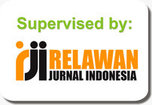Location Based Service for improving Chabot Disaster Management Evacuator Palu
Abstract
Keywords
Full Text:
PDF (Bahasa Indonesia)References
F. Wex, G. Schryen, S. Feuerriegel, and D. Neumann, Emergency response in natural disaster management: Allocation and scheduling of rescue units, Eur. J. Oper. Res., vol. 235, no. 3, pp. 697 708, 2014.
V. Nomor and A. D. A. N. Penanggulangan, The indonesian journal of politics and policy (ijpp), vol. 1, pp. 83 93, 2019.
R. A. Hadiguna, I. Kamil, A. Delati, and R. Reed, Implementing a web-based decision support system for disaster logistics: A case study of an evacuation location assessment for Indonesia, Int. J. Disaster Risk Reduct., vol. 9, pp. 38 47, 2014.
I. S. Wekke, Z. Sabara, M. A. Samad, A. Yani, R. Umam, and M. U. Palu, EARTHQUAKE , TSUNAMI , AND SOCIETY COOPERATION : EARLY FINDINGS IN PALU POST OF INDONESIA DISASTER.
PETA PERSEBARAN TITIK KUMPUL GEMPA TSUNAMI PALU, DONGGALA 2018. [Online]. Available: http://ugm.id/PetaBencanaPalu2018.
M. Saadatseresht, A. Mansourian, and M. Taleai, Evacuation planning using multiobjective evolutionary optimization approach, Eur. J. Oper. Res., vol. 198, no. 1, pp. 305 314, 2009.
M. Dong, H. Li, K. Ota, L. T. Yang, and H. Zhu, Multicloud-Based Evacuation Services for Emergency Management, IEEE Cloud Comput., vol. 1, no. 4, pp. 50 59, 2014.
O. Alani, Z. Alazawi, R. Mehmood, S. Altowaijri, and M. B. Abdljabar, A smart disaster management system for future cities, pp. 1 10, 2014.
S. Cresci, M. Tesconi, A. Cimino, and F. Dell Orletta, A Linguistically-driven Approach to Cross-Event Damage Assessment of Natural Disasters from Social Media Messages, pp. 1195 1200, 2016.
M. Imran, P. Mitra, and C. Castillo, Twitter as a Lifeline: Human-annotated Twitter Corpora for NLP of Crisis-related Messages, 2016.
G. Shalunts, G. Backfried, and K. Prinz, Sentiment Analysis of German Social Media Data for Natural Disasters, 11th Int. Conf. Inf. Syst. Cris. Response Manag., no. May, pp. 752 756, 2014.
D. Buscaldi and I. Hern ¡ndez-Farias, Sentiment Analysis on Microblogs for Natural Disasters Management: a Study on the 2014 Genoa Floodings, Proc. 24th Int. Conf. World Wide Web, pp. 1185 1188, 2015.
C. Cobb et al., Designing for the deluge: Understanding & Supporting the Distributed, Collaborative Work of Crisis Volunteers, Proc. 17th ACM Conf. Comput. Support. Coop. Work Soc. Comput. - CSCW 14, pp. 888 899, 2014.
I. Akg ¼n, F. G ¼m ¼ÅŸbuÄŸa, and B. Tansel, Risk based facility location by using fault tree analysis in disaster management, Omega (United Kingdom), 2015.
R. Khudabadi, A Recent Study on Early Disaster Warning & Evacuation System on Mobile Phones Using Google Cloud, vol. 02, pp. 501 503, 2015.
P. Debnath, S. Haque, S. Bandyopadhyay, and S. Roy, Post-disaster situational analysis from WhatsApp group chats of emergency response providers, Proc. Int. ISCRAM Conf., no. May, 2016.
D. Dutta, Developing an Intelligent Chat-bot Tool to assist high school students for learning general knowledge subjects, p. 13, 2017.
DOI: http://dx.doi.org/10.26623/transformatika.v18i1.1890
Refbacks
- There are currently no refbacks.
| View My Stats |
Jurnal Transformatika : Journal Information Technology by Department of Information Technology, Faculty of Information Technology and Communication, Semarang University is licensed under a Creative Commons Attribution 4.0 International License.









